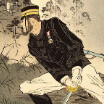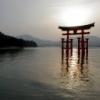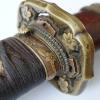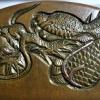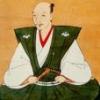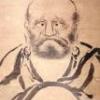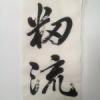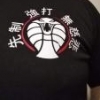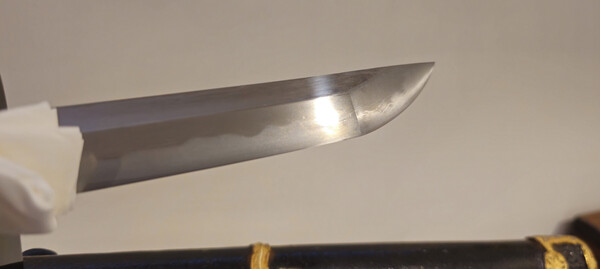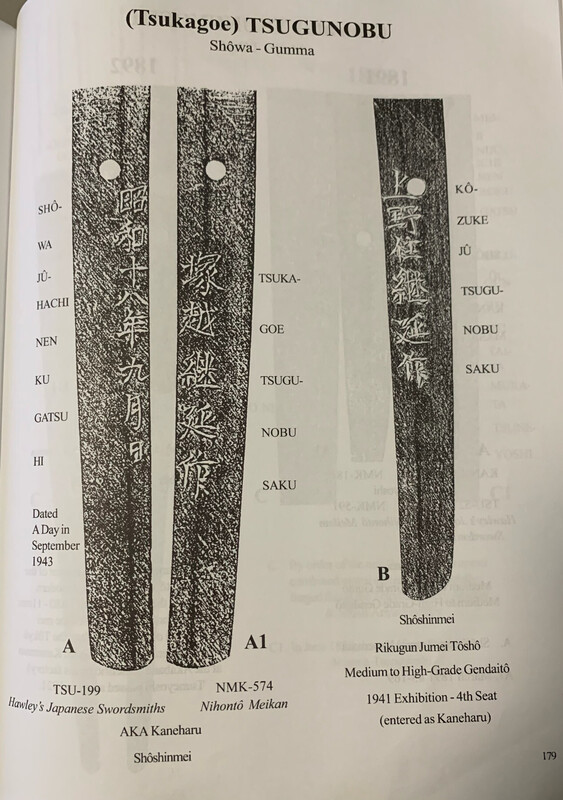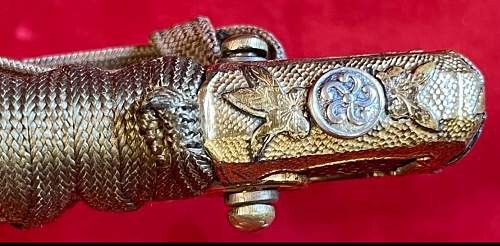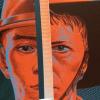Leaderboard
Popular Content
Showing content with the highest reputation on 02/17/2025 in all areas
-
14 points
-
Gimei is gimei and that's that. "nihonto-museum" is no valuable reference at all. And yes: Guido is a real character, always was. Sadly enough he is not able to participate anymore. As for you , "Dee", I have my doubts who you really are. Playing the "Lady-bonus" here for somebody else ? reinhard6 points
-
It doesn´t matter if it is Koto, Shinto or ShinShinto. All that matters is: it is a Japanese sword with an inscription and a fair price tag. And Dee likes it.5 points
-
トキワ Tokiwa - it is a location in Tokyo (Tokiwamatsu-chō) where Shigetsugu's forge was. Near present-day Shibuya. https://ja.wikipedia.org/wiki/常磐松町4 points
-
Not sure you know exactly what you are looking for. Mantetsu swords are purchased for their history and as militaria. They certainly aren't bought for their artistic traits. They don't exhibit nice hataraki or interesting hamon. They are arsenal swords, but made using certain techniques that increased their useability. Whether it's cleaned a bit or not isn't the prime factor in owning one of them. If you are looking for a nice WW2 sword with interesting hamon and showing hada/hataraki, then Mantetsu swords aren't where you should be looking. What were you expecting of this sword? It's a factory, not a particular smith. This is like buying a Type 95 Gunto and then lamenting that it doesn't have a nice polish or hamon.4 points
-
Back to the main topic… I have 2 gimei blades. First is a Hizen Tadahiro signed katana but deemed gimei by NTHK-NPO, but still judged as a Hizen blade of same approximate time period as Tadahiro with exact same workmanship. Second blade is an Awataguchi Tadatsuna wakizashi deemed gimei by NTHK, but still judged as a lower level student of Tadatsuna and blade exhibits typical Awataguchi traits. So if you want to study schools and activity, and aren’t worried about who you show it to or the naysayers, I have no problem with gimei… especially at a fraction of the price.3 points
-
Dear fellows collectors, I'd like to share with you the sword I've just brought home. She's a Kaneshige blade made in feb 1944 (and thanks to the members here that translated properly the nakago in my previous post). I apologize for the low quality pics, but I have to say that these objects are pretty hard to photograph.2 points
-
2 points
-
2 points
-
Not a new member... But I changed my username from GeorgeLuucas to Scogg Scogg is an abbreviation of my last name, and has also been a common nickname for me. I am sick being called George. Although I remain a big StarWars fan Cheers, -Sam2 points
-
2 points
-
I dont see Shinshinto, not with the nakago and worn horimono.2 points
-
If you are in Tokyo ‘at the end of the month’, I would recommend the antique market in Kawagoe, which always takes place on the 28th of the month. I've already been to a few flea markets in Kyoto, Tokyo and the surrounding area, but I've never discovered any really nice tsuba (at least for my taste). Once there were really better pieces to be found at a dealer, but I could have bought them in Ginza for the prices they were asking. And that's how I've done it so far, by buying from the well-known dealers in their shops. You have the advantage of being able to compare favourites directly, and you usually get a discount if you pay cash.2 points
-
Well put, Dee! I'm a little late, but I would say when it comes to actual high quality blades or well known smiths, it's a bit hard to keep out of the limelight, regardless if someone inadvertently draws attention to it. As well, we know FleaBay can be a minefield, but I'm sure we all skim across it in search of a treasure and by that, if one knowledgable person sees something, you can guarantee others do, as well! Short story, I was on GunBroker last year looking at Walther PPs just to pass some time, and saw an RSHA issued model. Won't go into details, but the organization was a part of the SS, not the Waffen-SS though, and about 6,000 were contracted to them. Main details are a serialized slide prior to it being put on all, and matching magazines if you're lucky to find them. About 5% are known to exist. I thought I was going to get a deal, since it wasn't labeled as that contract model, but I ended up in a bidding war with the most knowledgeable person on Walther PP/PPk variants. I ended up getting it for a decent price, though not a bargain. I took a risk since they didn't show any details on the mags, but when I picked it up, it ended up having one of the matching magazines. While I am a collector, and had been looking for one of these for as long as I was first able to buy handguns, I'm a shooter foremost, so will end up selling it. But I'm happy the hunt is over and was able to put out the information so it can be listed in the database for known surviving models for all to see. Hopefully the other mag is out there so the future owner can add it.2 points
-
The Tadahiro I bought without papers. The mei was sketchy, but it did come with a Kanzan Sato sayagaki. I was given some advice by some well known people in the field who felt it was gimei and when I submitted for papers it was also deemed gimei so it did not come as a surprise. A couple of the people who advised me did say something along the lines of “you can see why whoever added the gimei signature chose this blade… it was a clear Hizen blade and it would be easier to pass as a Tadahiro”. Now, the sayagaki? Three choices… 1) sayagaki is gimei, 2) someone matched this blade to a different signed saya, or 3) Kanzan Sato got this one wrong. The Tadatsuna blade I bought with the pink paper. Seller did not try to hide the fact blade was gimei. I still liked the blade and it was an example of a Awataguchi blade I could study in hand. It wasn’t perfect or the best example, but it was nice and I liked it.2 points
-
you could buy one from Grey for less https://japaneseswor...ck-dragon-residence/2 points
-
It was a nice run gents, but I didn't expect it going for a final 6.5k bid, that's one happy seller2 points
-
Most curious, yes. I suppose the added hitsu must have been very slight, for the three elements that you refer to, Piers, are all pretty similar in size and shape, so it doesn't seem that adding the hitsu affected these much, if at all. Most likely, the added hitsu merely intruded on the seppa-dai slightly. Here is another piece I am puzzling over as regards the motif elements. The one on the left is similar to that in the tsuba above, but is missing the three extra elements. In this piece, I am reminded of a carpenter's planer, such as that seen here: https://www.jauce.com/auction/q11728731182 points
-
Sadly I have to agree with the opinions here. The signature too is typical for one of these netsuke-like-objects (NLO). Remember, though, if you did not pay too much for it, you can actually use one of these to hang something from without fear of damaging it, and many people will even compliment you on it! One word of caution regarding the person who sold this to you. It is possible that they did not know much when they bought it, accepting whatever they were told, and happy to make a buck. Not all dealers are experts, most are still learning on the job, and some (not all) are even happy to be educated. A few years back I bought a neat little dragon Netsuke, but when I took it home for a really good look some faint mould lines between the legs showed that it was pressed resin. A month later I took it back to the same monthly market, and the dealer was more than happy to give my money back. Mr Maehata, salute! We've been good friends ever since and I have bought several things from him subsequently.2 points
-
Thanks, guys. Appreciate it. I don't know that this reading of the motif is correct (seems like quite a reach -- even the kuruma/wheel sukashi is dubious), but many thanks for the replies.2 points
-
Hi Steve, Namako ni kuruma sukashi - sea cucumber and wheel.2 points
-
2 points
-
Biggest in Tokyo is Oedo Sunday Market at the Tokyo International Forum - Yurakucho Station 1st stop on the JR Yamanote after JR Yamanote Tokyo Station 1st and 3rd Sundays weather permitting. https://www.antique-market.jp/english/ And definitely echo what Brian said about prices and origin of some items.2 points
-
Dear Military sword enthusiasts, I understand the standard length on a type 98 was about 66cm nagasa. - Was there a length requirement on type 94's? Any specific nakago length or sori requirements? Or was everything more or less custom made. My hypothesis is that the sword pictures below is a type 94, but it lacks the second hanger (which was removable, and hence makes any type of inference from my side difficult). My guess is that this is a type 94 with a general's tassel. But I'm not well versed in this field at all. The person pictured is field marshal Kotohito, which (likely?) would have had his shingunto custom made. - Would this have been a type 94, or a type 98? - Anyone has perhaps a better picture of this Gunto to share? - Anyone knows the whereabouts of the Gunto? (museum, somewhere?) it should be adorned by the family crest of the Kaninomiya. Below, the (short) sword of his son who was a tank officer. I believe that this particular is in the USA, according to Omura, and is published in an american book on the topic. Thank you for your insights! Hoshi1 point
-
1 point
-
Hi boys and girls while watching the sale of the katana by Kasama Shigetsugu today on eBay it got me thinking why some of Shigetsugu’s swords forged on the estate of Tōyama Mitsuru have an inscription stating made on the estate of the venerable Tōyama Mitsuru while other swords forged by Shigetsugu on the estate have the hot stamp of Tōyama Mitsuru ,were these swords made as gifts? Did other smiths who forged swords there use this stamp as well ,Curious to here your thoughts some pics of the hot stamp. cheers Chris H1 point
-
1 point
-
Vielen Dank für die viele Arbeit! Dann habe ich hier also eine Klinge eines hervorragenden Schmiedes oder eine auf der an ihn erinnert wird. Genau wird das wohl anhand des Fotos niemand bestimmen können. Auf alle Fälle ein glücklicher Fund! PS: Ich schreibe auf deutsch, übersetzen kann vermutlich Google.1 point
-
1 point
-
The Japanese write that 'Kantei is the foundation for Japanese sword appreciation.' They are correct in every sense. 'Forgive them for they know not what they do.' Principles.pdf https://www.pbs.org/...hailand/buddhism.htm1 point
-
I'm going to be quite bold here. I believe this could be a Shinshinto, blade.1 point
-
I've always wondered what you mean by “study piece”. For me, all quality swords signed, shoshin and in good polished condition are worthy of study (blade in hand, of course as you can't learn anything from photos).1 point
-
1 point
-
Some poor soul going to buy that thinking they have whatever the Lanes described it as, whatever that is. I stopped reading near the top, looks like someone got carried away, the opposite of writers block, lots and lots of caffeine maybe1 point
-
IF I manage to go to Japan this year (and I am frantically saving as I REALLY REALLY want to go) then I'm looking at arriving around the 23rd October until just after the DTI. Sad thing is that this misses the 3rd Sunday of October, and the markets on the 1st Sunday...that's the DTI. Which is a pity, as I love Tokyo flea and antiques markets. Won't be travelling around Japan this time as I limited leave available, and want to spend 4 or 5 days in Thailand for the first time on the way back. Pity...I wanted to see Sapporo for once. But we will have to see if I can swing the trip. As much as the Yen has fallen, the Rand has done worse. I can pay for flights or accommodation...not both. Do as many markets as you can. You may not buy a lot, but it's awesome to see stuff that is actually antique among stuff made yesterday. But there are few bargains. If you can find a private person selling stuff off, you can score. But most are professional dealers who sell online when they are not at the market, and they think every tsuba is worth $500+1 point
-
This may be of interest 21 pages of Interesting Pre - War Photographs of what became Camp Zama. Courtesy of U.S. Army Japan Website https://www.usarj.ar...1935_1945_202101.pdf1 point
-
The oshigata from the Kokon Meizukushi taizen is said to be a nidai's tanto and no one has ever seen this tanto. Official Japanese literature makes no mention whatsoever of tanto by Kinju with a nengo and authenticated. For me, a blog isn't a reliable source, you can say anything (invoke Heisenberg's principle of indeterminacy about a Norishige tanto, for example). I would add that hamon does not correspond1 point
-
1 point
-
Hard to believe how quiet this thread has been, it would be nice to see more quality Gendai posted again. Tsukagoshi Tsugunobu Katana dated 1944, made for a Hideo Sanyogawa/Miyokawa. Tsugunobu originally signed as Kaneharu and hailed from Gunma. He studied under Ryuminsai Kanetomo before becoming the 16th student of Kasama Ikkansai Shigetsugu. He was an RJT smith and rated Joko No Retsu by Akihide, and East Komusubi on the Gendai Tosho Banzuke. While clearly a well accomplished smith, there aren't too many swords available online. Good Kai Gunto mounts with Mon, tassel, and leather cover. The Kanji on the Tsuka are interesting in that they note the fleet assignment and have a different officers name, presumably Lt Matsuoka ordered the sword for Lt Sanyogawa/Miyokawa, who is listed as graduating in the 74th class at Etajima Naval college. The blade is the classic Shigetsugu style Bizen Den. 四海軍予え- (Fourth Naval Fleet Preliminary/Reserve) 松岡大尉 - (Lieutenant Matsuoka)1 point
-
Rock Island protects themselves by using the word "style" in the description, like "Japaese style sword", "Japanese style NCO sword" ect.1 point
-
1 point
-
I’m sure the Auctioneers (I’m not familiar with this one) will have their rear end well protected by “terms and conditions” ….usually shifting the onus onto the buyers to prove otherwise. But, going back to Ancient Rome, the principle of “caveat emptor” has been the over-riding guidance for any buyer of anything and it’s wise to take heed. I agree it’s nasty, all fraud is and nowadays you almost start from the premise that all is not what you hope it is. The modern world…… Words of my long gone grandfather from over 60 years ago suggest was it always thus…..”believe nothing you hear and half what your see”….and it’s got a lot worse since then. Even the major Auction Houses have horrendous skeletons they hope will never emerge from the closet.1 point
-
I think the seller should accept some responsibility for selling fake/forged/inaccurately described items. We condemn the poor buyer for buying this stuff. But he/she is simply relying on the opinion of the auction house. In other words, the buyer trusts the seller's assessment because we can't be experts at everything. Personally, I don't blame the victim for getting duped by, what is supposed to be, a trusted source. I think the auction site should be held criminally and/or financially liable. John C.1 point
-
Thanks, David. It's a great resource for learning an bit more about tsuba attributions1 point
-
1 point
-
Type 98 with a brown tassel and large Seki 関 stamp. 酒向兼茂 Sakō Kaneshige. As the swordsmith is a bit of an unknown, updating the thread for future reference.1 point
-
My kaigunto, with silver mon on menuki. Good quality fittings with same-nuri saya. Blade by Ishido Mitsunobu (aka Teruhide) + Koa. Although I no longer own it, I previously had a kaigunto with silver mon on kabuto (crossed hawk feather design). That was a Shinto blade signed: “ Hoki no kami Fujiwara Nobutaka” and it had a surrender label which gave owners name as Surgeon Lieutenant Yasuo Ono. The label was included in Richard Fuller’s book on surrender tags / labels, page 95. I mention that because in that book approx 70 pages show army surrender labels whilst only about a dozen pages show navy. So, this question of why more silver mons on Shingunto than kaigunto can equally be applied to surrender labels. I suspect it has little to do with status or wealth and everything to do with personal choice and numerical statistics of those swords which survived. Heavy losses of their main capital ships, on which one assumes many senior officers perished along with their swords is a known fact. For a demonstration of that, take the largest number of Japanese officers known to surrender in one place, ie Jan 1946 Bangkok, Siam to Maj. Gen. Evans…that consisted of eighteen army Generals and just two navy admirals. So my guess is, we see fewer mon on kaigunto when compared with Shingunto simply because there are fewer to see. Kevin.1 point
-
1 point
-
Here is a favorite Kiku tsuba of mine I traded to Skip Holbrook for a NBTHK papered Higo Kinko tsuba a few years ago. The size was exceptionally large, and the iron was extremely nice and had a great feel in hand. It measures 10.3 cm (4.1 inches) wide by 10.4 cm (4.01 inches) high. It is 6.6 mm (0.3 inches) at the rim and gently thins toward the middle.1 point
-
1 point
This leaderboard is set to Johannesburg/GMT+02:00

